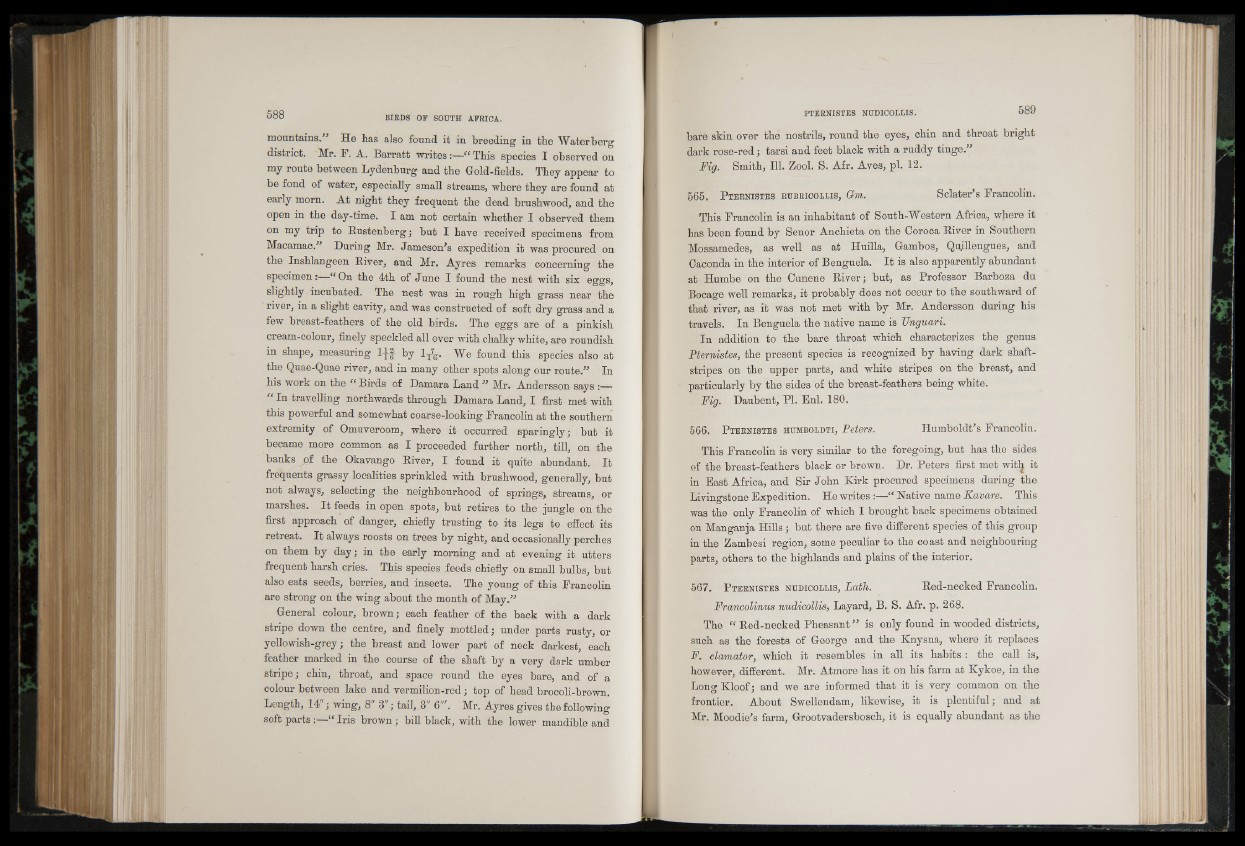
mountains.” He has also found it in breeding in the Waterberg
district. Mr. F. A. Barratt writes:—“ This species I observed on
my route between Lydenburg and the Gold-fields. They appear to
be fond of water, especially small streams, where they are found at
early morn. At night they frequent the dead brushwood, and the
open in the day-time. I am not certain whether I observed them
on my trip to Rustenberg; but I have received specimens from
Macamac. 5 During Mr. Jameson’s expedition it was procured on
the Inshlangeen River, and Mr. Ayres remarks concerning the
specimen: “ On the 4th of June I found the nest with six eggs,
slightly incubated. The nest was in rough high grass near the
river, in a slight cavity, and was constructed of soft dry grass and a
few breast-feathers of the old birds. The eggs are of a pinkish
cream-colour, finely speckled all over with chalky white, are roundish
in shape, measuring I f f by 1T\ . We found this species also at
the Quae-Quae river, and in many other spots along our route.” In
his work on the “ Birds of Damara Land ” Mr. Andersson says :—
“ In travelling northwards through Damara Land, I first met with
this powerful and somewhat coarse-looking Francolin at the southern
extremity of Omuveroom, where it occurred sparingly; but it
became more common as I proceeded further north, till, on the
banks p f the Okavango River, I found it quite abundant. It
frequents grassy localities sprinkled with brushwood, generally, but
not always, selecting the neighbourhood of springs, streams, or
marshes. I t feeds in open spots, but retires to the jungle on the
first approach of danger, chiefly trusting to its legs to effect its
retreat. It always roosts on trees by night, and occasionally perches
on them by day; in the early morning and at evening it utters
frequent harsh cries. This species feeds chiefly on small bulbs, but
also eats seeds, berries, and insects. The young of this Francolin
are strong on the wing about the month of May.”
General colour, brown; each feather of the back with a dark
stripe down the centre, and finely mottled; under parts rusty, or
yellowish-grey; the breast and lower part of neck darkest, each
feather marked in the course of the shaft by a very dark umber
stripe; chin, throat, and space round the eyes bare, and of a
colour between lake and vermilion-red; top of head brocoli-brown.
Length, 14"; wing, 8" 3"; tail, .3" 6"'. Mr. Ayres gives the following
soft parts:—1“ Iris brown; bill black, with the lower mandible and
bare skin over the nostrils, round the eyes, chin and throat bright
dark rose-red; tarsi and feet black with a ruddy tinge.”
Fig. Smith, 111. Zool. S. Afr. Aves, pi. 12.
565. P t e r n i s t e s r u b r ic o l l i s , Om. Sclater’s Francolin.
This Francolin is an inhabitant of South-Western Africa, wfiere it
has been found by Senor Anchieta on the Coroca River in Southern
Mossamedes, as well as at Huilla, Gambos, Qujillengues, and
Oaconda in the interior of Benguela. I t is also apparently abundant
at Humbe on the Cunene River; but, as Professor Barboza du
Bocage well remarks, it probably does not occur to the southward of
that river, as it was not met with by Mr. Andersson during his
travels. In Benguela the native name is Unguari.
In addition to the bare throat which characterizes the genus
Pternistes, the present species is recognized by having dark shaft-
stripes on the upper parts, and white stripes on the breast, and
particularly by the sides of the breast-feathers being white.
Fig. Daubent, PI. Enl. 180.
566. P t e r n i s t e s h u m b o l d t i , Peters. Humboldt’s Francolin.
This Francolin is very similar to the foregoing, but has the sides
of the breast-feathers black or brown. Dr. Peters first met with it
in East Africa, and Sir John Kirk procured specimens during the
Livingstone Expedition. He writes:—“ Native name Kavare. This
was the only Francolin of which I brought back specimens obtained
on Manganja Hills; but there are five different species of this group
in the Zambesi region, some peculiar to the coast and neighbouring
parts, others to the highlands and plains of the interior.
567. P t e r n i s t e s n u d ic o l l i s , Lath. Red-necked Francolin.
Francolinus nudicollis, Layard, B. S. Afr. p. 268.
The “ Red-necked Pheasant ” is only found in wooded districts,
such as the forests of George and the Knysna, where it replaces
F. clamator, which it resembles in all its habits : the call is,
however, different. Mr. Atmore has it on his farm at Kykoe, in the
Long Kloof; and we are informed that it is very common on the
frontier. About Swellendam, likewise, it is plentiful; and at
Mr. Moodie’s farm, Grootvadersbosch, it is equally abundant as the